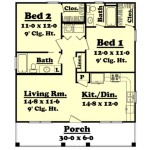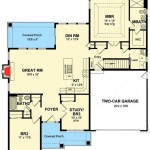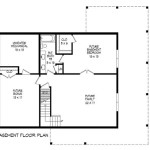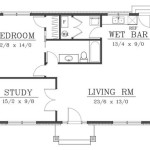Small Split Level Home Plans: Maximizing Space and Functionality
Small split level home plans offer a unique and often overlooked solution for homeowners seeking efficient use of space with a distinctive architectural character. These designs, characterized by staggered floor levels connected by short flights of stairs, provide a practical approach to separating living areas while maintaining a sense of openness. The inherent layout of a split level home lends itself well to various lot conditions and can be adapted to suit diverse lifestyles.
The appeal of split level homes lies in their ability to discreetly delineate zones within a relatively compact footprint. This vertical stratification creates a sense of privacy and functionality, differentiating living, sleeping, and recreational spaces without resorting to long hallways and traditional two-story layouts. This style became popular in the mid-20th century, and while modern designs often incorporate contemporary elements, the fundamental principles of spatial organization remain relevant.
When considering small split level home plans, understanding the defining features and potential benefits is crucial. This article delves into the key aspects of these designs, explores their advantages and considerations, and highlights design principles that optimize space utilization.
Understanding the Defining Characteristics of Split Level Homes
Split level homes are distinguished by their multiple levels, typically three or four, connected by short staircases. This differentiates them from traditional two-story homes or ranch-style layouts. The standard split level design usually includes a main level, an upper level, and a lower level. Variations exist, such as the side-split and back-split, which alter the arrangement of the levels relative to the street and backyard.
The main level generally encompasses living areas like the living room, dining room, and kitchen. This level is often situated at grade, providing easy access to the front yard and street. The upper level typically houses bedrooms and bathrooms, offering a more private and quiet zone. This level is elevated from the main level by a short flight of stairs, usually half a story.
The lower level, often partially or fully below grade, can serve various purposes. It may include a family room, recreation area, laundry room, or even a home office. Depending on the design and the slope of the land, this level may have windows or direct access to the backyard. A fourth level, sometimes referred to as a sub-basement, may be included for storage or utilities.
The arrangement of these levels allows for a natural separation of functions. The vertical separation minimizes noise transfer between living and sleeping areas, creating a more peaceful environment. Furthermore, the staggered levels can be advantageous for sites with sloping topography, allowing the house to more naturally integrate with the landscape.
The specific design of a split level home plan can vary greatly depending on the architect and homeowners' preferences. Contemporary designs often incorporate open-concept layouts and larger windows to enhance natural light and create a more modern aesthetic. However, the core principle remains the same: multiple, staggered levels that maximize space and functionality.
Advantages and Considerations of Small Split Level Home Plans
Small split level homes offer several advantages, particularly in terms of space utilization and cost-effectiveness. The staggered design allows for a greater separation of living areas within a smaller footprint compared to a traditional two-story home. This can be particularly appealing for families with varying needs and schedules.
One significant advantage is the potential for cost savings. Split level construction can sometimes be more economical than building a full two-story structure, especially on sloping lots. The reduced foundation requirements and the ability to utilize partially below-grade space can contribute to lower construction costs. Additionally, the relatively compact footprint often translates into lower heating and cooling costs.
Another benefit is the inherent privacy offered by the staggered levels. The separation of living and sleeping areas minimizes noise transfer, creating a more peaceful environment for both activities. This can be particularly valuable in households with young children or individuals who work from home.
However, there are also considerations to keep in mind when considering small split level home plans. The short flights of stairs between levels can be challenging for individuals with mobility issues. Careful planning is essential to ensure accessibility is addressed, potentially through the incorporation of ramps, lifts, or thoughtful floor plan modifications.
Another potential drawback is the perceived lack of flow between the levels. The staggered design can sometimes create a fragmented feeling, particularly if the interior layout is not well-designed. Optimizing the flow between levels through strategic placement of doorways and openings is crucial. Modern designs often address this issue by incorporating open-concept layouts and minimizing the number of walls.
Resale value is another factor to consider. While split level homes are often more affordable than their two-story counterparts, their market appeal may vary depending on the region and the preferences of potential buyers. A well-maintained and updated split level home can still be a desirable option, particularly for first-time homebuyers or those seeking a budget-friendly alternative.
Ultimately, the decision to choose a small split level home plan depends on individual needs, preferences, and budget. Weighing the advantages and considerations carefully is essential to ensure that the chosen design meets the specific requirements of the homeowner.
Optimizing Space and Functionality in Small Split Level Designs
Maximizing space and functionality is paramount in small split level home designs. Careful planning and attention to detail are essential to create a comfortable and efficient living environment. Several design principles can be applied to optimize space utilization and enhance the overall livability of the home.
One key principle is to embrace open-concept layouts. Removing walls between the living room, dining room, and kitchen can create a more spacious and airy feel. This also allows for better flow between the levels and enhances natural light penetration. Consider the traffic patterns and ensure that the layout is functional and efficient.
Another important aspect is to maximize natural light. Large windows and skylights can brighten interior spaces and create a more welcoming atmosphere. Consider the orientation of the house and position windows strategically to capture sunlight throughout the day. Light-colored walls and ceilings can also help to reflect light and make the space feel larger.
Effective storage solutions are crucial in small homes. Built-in shelving, cabinets, and drawers can maximize storage space without taking up valuable floor area. Consider utilizing vertical space by installing tall cabinets and shelves. Under-stair storage is another often-overlooked area that can be utilized effectively.
Multifunctional spaces can also help to optimize space utilization. A guest room that doubles as a home office or a dining room that can be easily converted into a playroom can provide flexibility and adaptability. Consider furniture that can serve multiple purposes, such as a sofa bed or a coffee table with built-in storage.
Paying attention to details such as flooring, lighting, and paint colors can also make a significant difference in small spaces. Light-colored flooring can create a sense of spaciousness, while strategic lighting can highlight architectural features and create a more inviting ambiance. Neutral paint colors can provide a blank canvas that allows for personalization through furniture and accessories.
Landscaping can also play a role in enhancing the livability of a small split level home. Creating outdoor living spaces, such as patios or decks, can extend the living area and provide opportunities for relaxation and entertainment. Carefully planned landscaping can also enhance privacy and create a more visually appealing exterior.
By applying these design principles, homeowners can maximize space and functionality in small split level home designs, creating a comfortable, efficient, and stylish living environment.
The prevalence of split level homes is a testament to their unique ability to offer distinct spatial separation within a relatively compact area. Their adaptation to various terrains and cost-effectiveness further contribute to their enduring appeal in the housing market. With thoughtful planning and design, these homes can provide comfortable and functional living spaces for a wide range of homeowners.
Ultimately, the success of a small split level home plan hinges on the homeowner's careful consideration of their specific needs, the site's characteristics, and the integration of design principles that maximize space and functionality. Understanding these factors and carefully planning the layout and features can create a home that is both aesthetically pleasing and functionally fulfilling.

2 Bedroom Split Level House Plan 141kr Design Plus Many More P Small Floor Plans Tiny

Small Split Level Home Plan 22354dr Architectural Designs House Plans
Split Level Homes Designs G J Gardner

Split Level Homes 50 Floor Plan Examples Archdaily

Tiny Split Level House Plan 90301pd Architectural Designs Plans

Split Level House Plans Floor Designs

House Stuff Split Level Floor Plans Remodeling

Split Level House Plans Home Designs The Designers

Split Level Homes 50 Floor Plan Examples Archdaily

House Plan 2006310 Narrow Lot Bi Level By Edesignsplans Ca Under 1000 Sq Ft This Small Is Ma Plans Floor








